300487 Mechatronic Design: E-Bike Design for Smart Campus WSU
VerifiedAdded on 2023/06/11
|36
|9617
|457
Project
AI Summary
This project report details the design and development of an E-bike for Western Sydney University's Smart Campus initiative. It covers the background of E-bikes, design objectives, and basic design decisions, including component selection and frame design. The report includes a design analysis, consideration of Design for X (DFX) principles, and a final E-bike design rendered using CAD software. Performance criteria, production costs, and sustainability aspects are also discussed. The project aims to provide a convenient, safe, and sustainable mode of transport for students and staff within the university campus. Desklib provides access to this project and many other solved assignments for students.
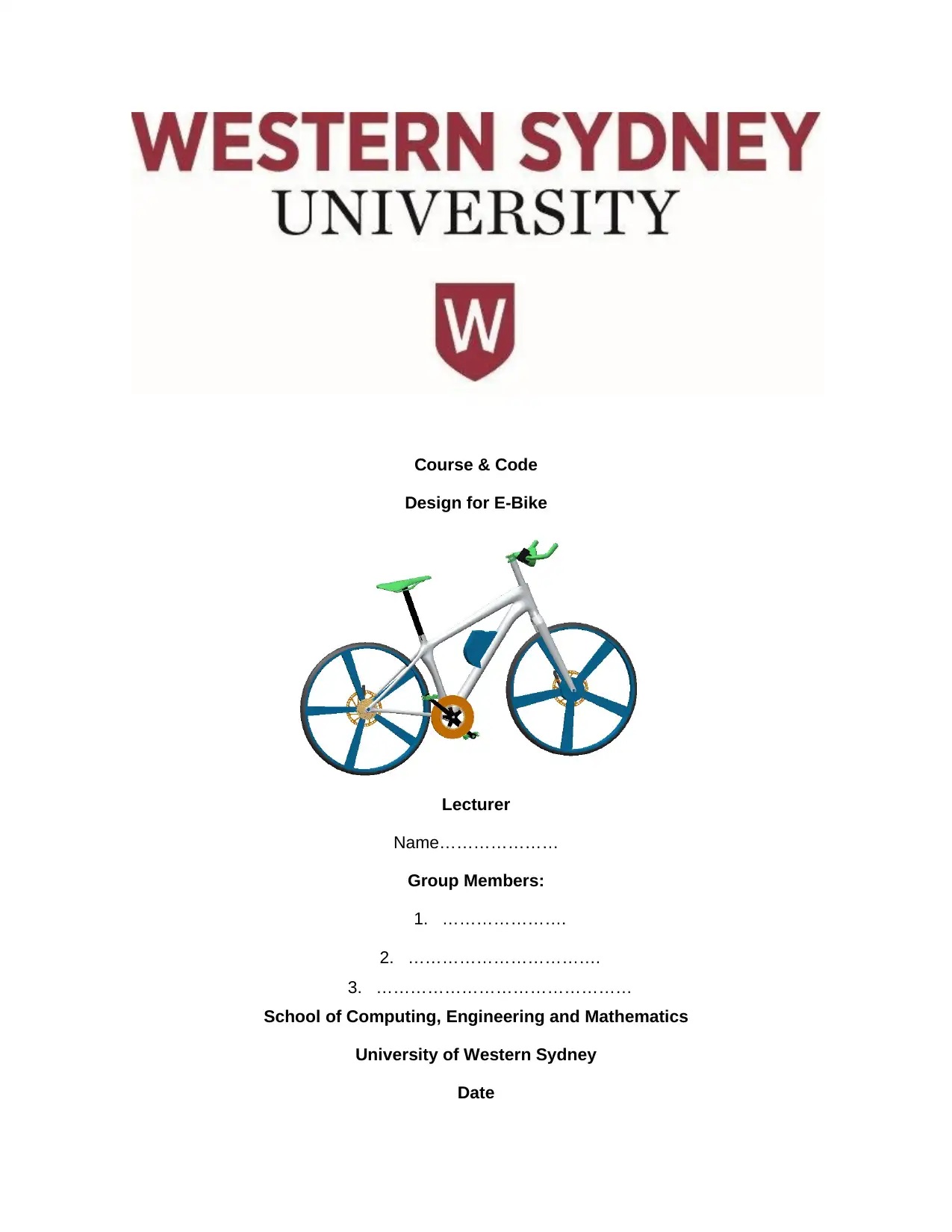
Course & Code
Design for E-Bike
Lecturer
Name…………………
Group Members:
1. ………………….
2. …………………………….
3. ………………………………………
School of Computing, Engineering and Mathematics
University of Western Sydney
Date
Design for E-Bike
Lecturer
Name…………………
Group Members:
1. ………………….
2. …………………………….
3. ………………………………………
School of Computing, Engineering and Mathematics
University of Western Sydney
Date
Paraphrase This Document
Need a fresh take? Get an instant paraphrase of this document with our AI Paraphraser
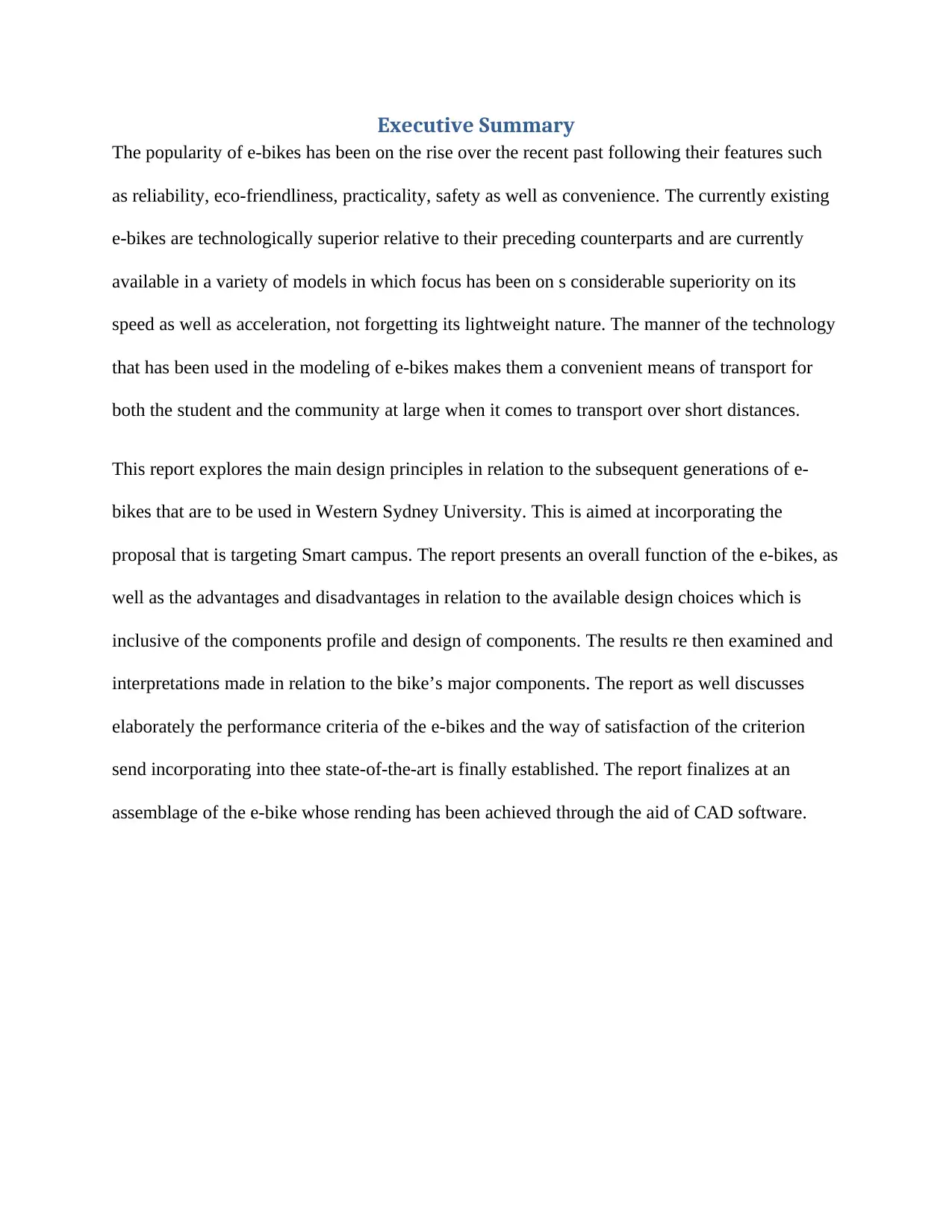
Executive Summary
The popularity of e-bikes has been on the rise over the recent past following their features such
as reliability, eco-friendliness, practicality, safety as well as convenience. The currently existing
e-bikes are technologically superior relative to their preceding counterparts and are currently
available in a variety of models in which focus has been on s considerable superiority on its
speed as well as acceleration, not forgetting its lightweight nature. The manner of the technology
that has been used in the modeling of e-bikes makes them a convenient means of transport for
both the student and the community at large when it comes to transport over short distances.
This report explores the main design principles in relation to the subsequent generations of e-
bikes that are to be used in Western Sydney University. This is aimed at incorporating the
proposal that is targeting Smart campus. The report presents an overall function of the e-bikes, as
well as the advantages and disadvantages in relation to the available design choices which is
inclusive of the components profile and design of components. The results re then examined and
interpretations made in relation to the bike’s major components. The report as well discusses
elaborately the performance criteria of the e-bikes and the way of satisfaction of the criterion
send incorporating into thee state-of-the-art is finally established. The report finalizes at an
assemblage of the e-bike whose rending has been achieved through the aid of CAD software.
The popularity of e-bikes has been on the rise over the recent past following their features such
as reliability, eco-friendliness, practicality, safety as well as convenience. The currently existing
e-bikes are technologically superior relative to their preceding counterparts and are currently
available in a variety of models in which focus has been on s considerable superiority on its
speed as well as acceleration, not forgetting its lightweight nature. The manner of the technology
that has been used in the modeling of e-bikes makes them a convenient means of transport for
both the student and the community at large when it comes to transport over short distances.
This report explores the main design principles in relation to the subsequent generations of e-
bikes that are to be used in Western Sydney University. This is aimed at incorporating the
proposal that is targeting Smart campus. The report presents an overall function of the e-bikes, as
well as the advantages and disadvantages in relation to the available design choices which is
inclusive of the components profile and design of components. The results re then examined and
interpretations made in relation to the bike’s major components. The report as well discusses
elaborately the performance criteria of the e-bikes and the way of satisfaction of the criterion
send incorporating into thee state-of-the-art is finally established. The report finalizes at an
assemblage of the e-bike whose rending has been achieved through the aid of CAD software.
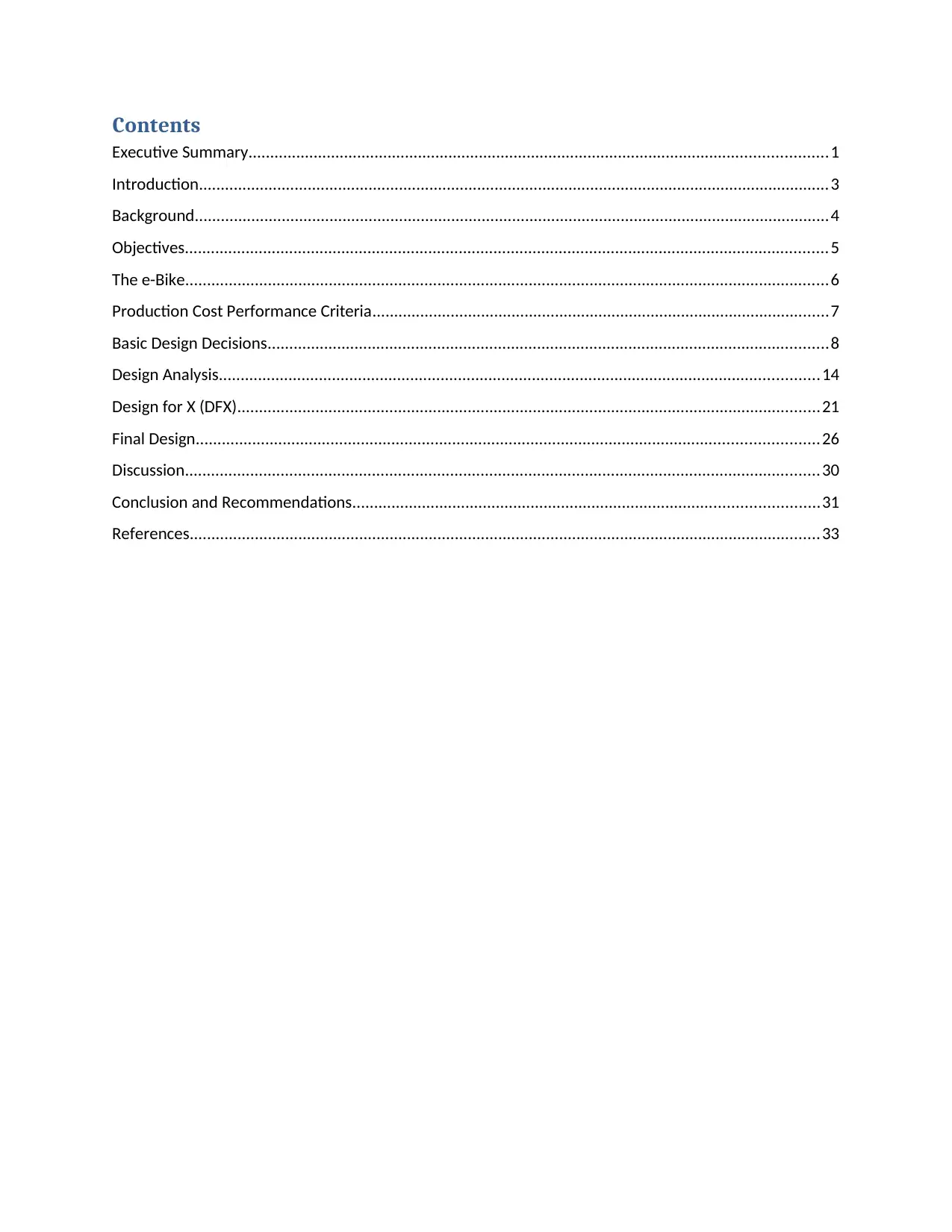
Contents
Executive Summary.....................................................................................................................................1
Introduction.................................................................................................................................................3
Background..................................................................................................................................................4
Objectives....................................................................................................................................................5
The e-Bike....................................................................................................................................................6
Production Cost Performance Criteria.........................................................................................................7
Basic Design Decisions.................................................................................................................................8
Design Analysis..........................................................................................................................................14
Design for X (DFX)......................................................................................................................................21
Final Design...............................................................................................................................................26
Discussion..................................................................................................................................................30
Conclusion and Recommendations...........................................................................................................31
References.................................................................................................................................................33
Executive Summary.....................................................................................................................................1
Introduction.................................................................................................................................................3
Background..................................................................................................................................................4
Objectives....................................................................................................................................................5
The e-Bike....................................................................................................................................................6
Production Cost Performance Criteria.........................................................................................................7
Basic Design Decisions.................................................................................................................................8
Design Analysis..........................................................................................................................................14
Design for X (DFX)......................................................................................................................................21
Final Design...............................................................................................................................................26
Discussion..................................................................................................................................................30
Conclusion and Recommendations...........................................................................................................31
References.................................................................................................................................................33
⊘ This is a preview!⊘
Do you want full access?
Subscribe today to unlock all pages.

Trusted by 1+ million students worldwide
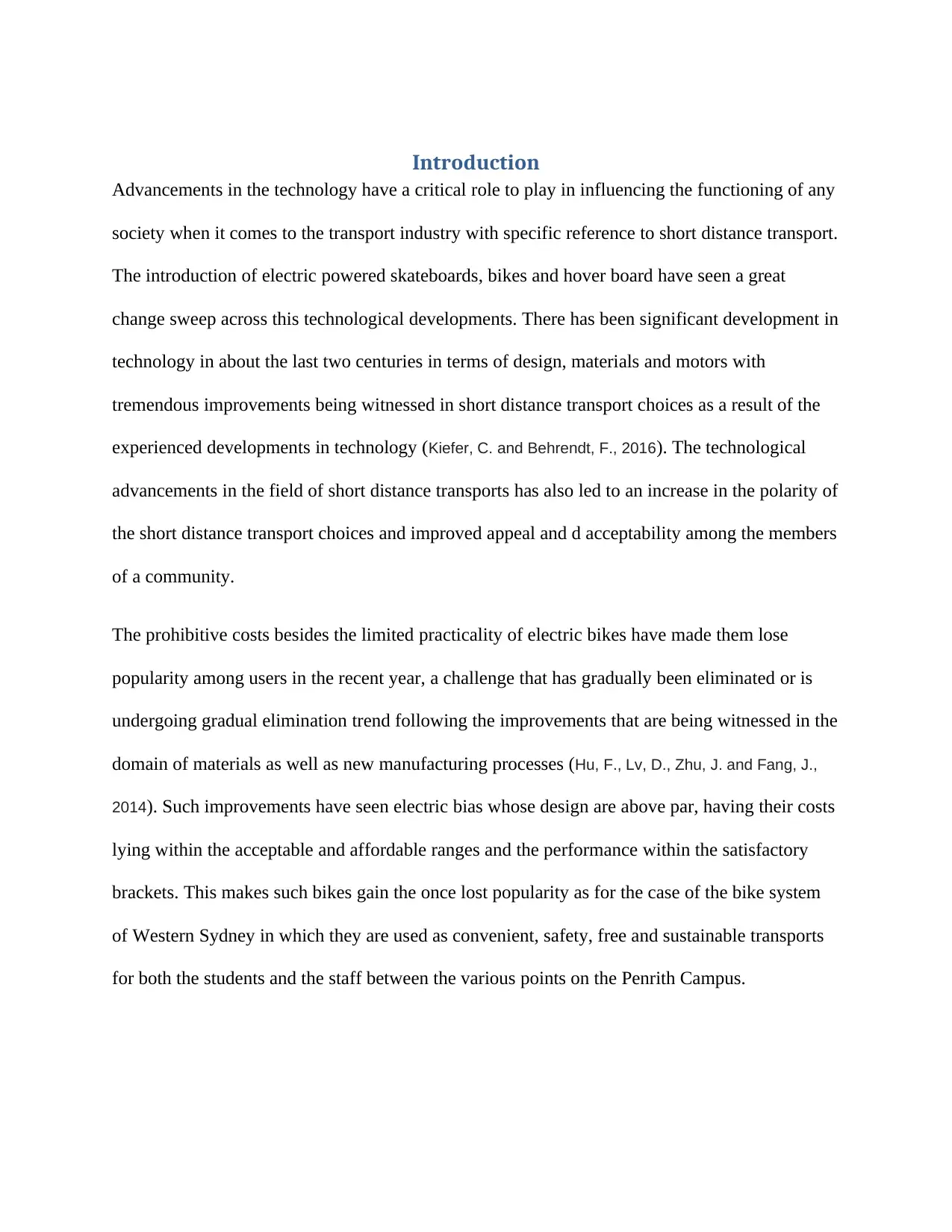
Introduction
Advancements in the technology have a critical role to play in influencing the functioning of any
society when it comes to the transport industry with specific reference to short distance transport.
The introduction of electric powered skateboards, bikes and hover board have seen a great
change sweep across this technological developments. There has been significant development in
technology in about the last two centuries in terms of design, materials and motors with
tremendous improvements being witnessed in short distance transport choices as a result of the
experienced developments in technology (Kiefer, C. and Behrendt, F., 2016). The technological
advancements in the field of short distance transports has also led to an increase in the polarity of
the short distance transport choices and improved appeal and d acceptability among the members
of a community.
The prohibitive costs besides the limited practicality of electric bikes have made them lose
popularity among users in the recent year, a challenge that has gradually been eliminated or is
undergoing gradual elimination trend following the improvements that are being witnessed in the
domain of materials as well as new manufacturing processes (Hu, F., Lv, D., Zhu, J. and Fang, J.,
2014). Such improvements have seen electric bias whose design are above par, having their costs
lying within the acceptable and affordable ranges and the performance within the satisfactory
brackets. This makes such bikes gain the once lost popularity as for the case of the bike system
of Western Sydney in which they are used as convenient, safety, free and sustainable transports
for both the students and the staff between the various points on the Penrith Campus.
Advancements in the technology have a critical role to play in influencing the functioning of any
society when it comes to the transport industry with specific reference to short distance transport.
The introduction of electric powered skateboards, bikes and hover board have seen a great
change sweep across this technological developments. There has been significant development in
technology in about the last two centuries in terms of design, materials and motors with
tremendous improvements being witnessed in short distance transport choices as a result of the
experienced developments in technology (Kiefer, C. and Behrendt, F., 2016). The technological
advancements in the field of short distance transports has also led to an increase in the polarity of
the short distance transport choices and improved appeal and d acceptability among the members
of a community.
The prohibitive costs besides the limited practicality of electric bikes have made them lose
popularity among users in the recent year, a challenge that has gradually been eliminated or is
undergoing gradual elimination trend following the improvements that are being witnessed in the
domain of materials as well as new manufacturing processes (Hu, F., Lv, D., Zhu, J. and Fang, J.,
2014). Such improvements have seen electric bias whose design are above par, having their costs
lying within the acceptable and affordable ranges and the performance within the satisfactory
brackets. This makes such bikes gain the once lost popularity as for the case of the bike system
of Western Sydney in which they are used as convenient, safety, free and sustainable transports
for both the students and the staff between the various points on the Penrith Campus.
Paraphrase This Document
Need a fresh take? Get an instant paraphrase of this document with our AI Paraphraser
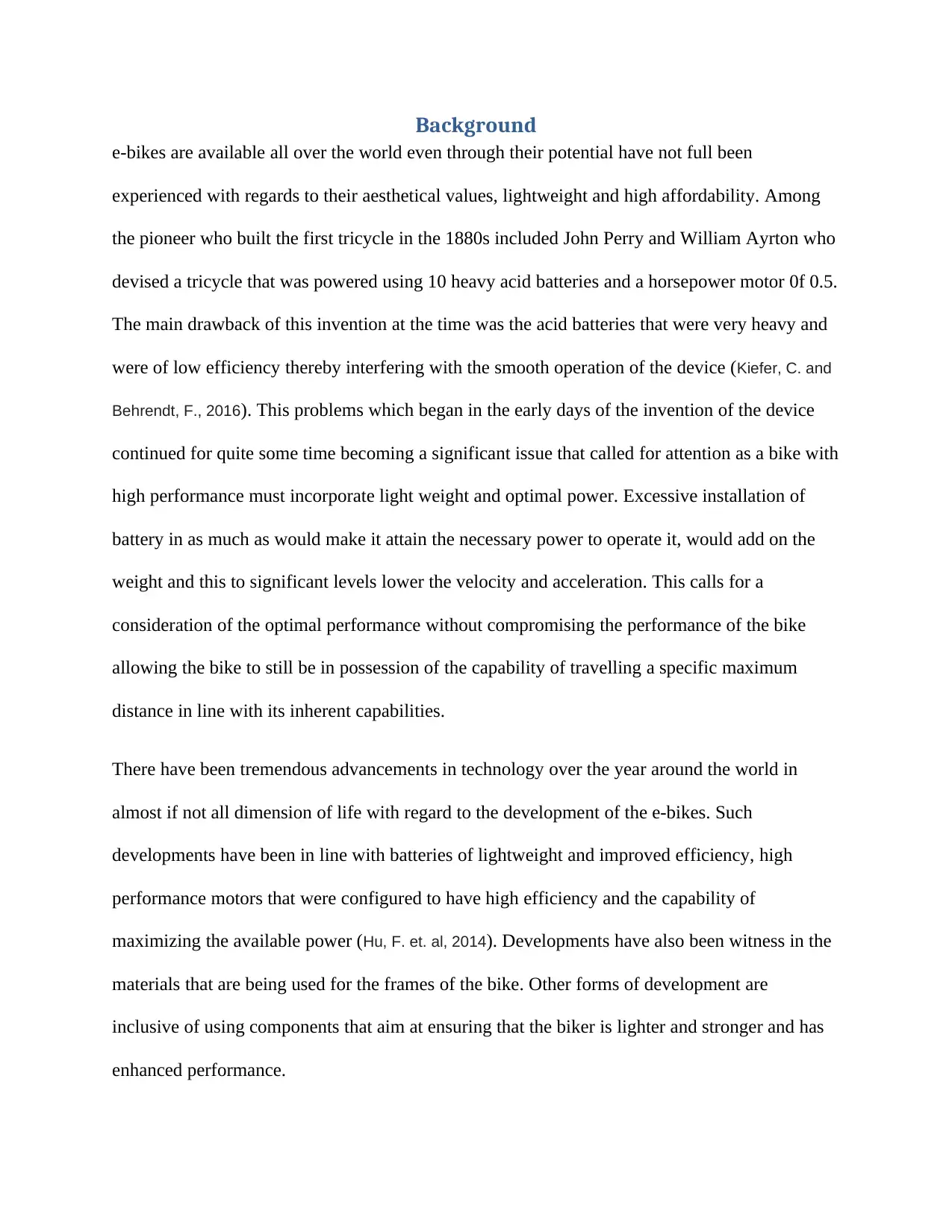
Background
e-bikes are available all over the world even through their potential have not full been
experienced with regards to their aesthetical values, lightweight and high affordability. Among
the pioneer who built the first tricycle in the 1880s included John Perry and William Ayrton who
devised a tricycle that was powered using 10 heavy acid batteries and a horsepower motor 0f 0.5.
The main drawback of this invention at the time was the acid batteries that were very heavy and
were of low efficiency thereby interfering with the smooth operation of the device (Kiefer, C. and
Behrendt, F., 2016). This problems which began in the early days of the invention of the device
continued for quite some time becoming a significant issue that called for attention as a bike with
high performance must incorporate light weight and optimal power. Excessive installation of
battery in as much as would make it attain the necessary power to operate it, would add on the
weight and this to significant levels lower the velocity and acceleration. This calls for a
consideration of the optimal performance without compromising the performance of the bike
allowing the bike to still be in possession of the capability of travelling a specific maximum
distance in line with its inherent capabilities.
There have been tremendous advancements in technology over the year around the world in
almost if not all dimension of life with regard to the development of the e-bikes. Such
developments have been in line with batteries of lightweight and improved efficiency, high
performance motors that were configured to have high efficiency and the capability of
maximizing the available power (Hu, F. et. al, 2014). Developments have also been witness in the
materials that are being used for the frames of the bike. Other forms of development are
inclusive of using components that aim at ensuring that the biker is lighter and stronger and has
enhanced performance.
e-bikes are available all over the world even through their potential have not full been
experienced with regards to their aesthetical values, lightweight and high affordability. Among
the pioneer who built the first tricycle in the 1880s included John Perry and William Ayrton who
devised a tricycle that was powered using 10 heavy acid batteries and a horsepower motor 0f 0.5.
The main drawback of this invention at the time was the acid batteries that were very heavy and
were of low efficiency thereby interfering with the smooth operation of the device (Kiefer, C. and
Behrendt, F., 2016). This problems which began in the early days of the invention of the device
continued for quite some time becoming a significant issue that called for attention as a bike with
high performance must incorporate light weight and optimal power. Excessive installation of
battery in as much as would make it attain the necessary power to operate it, would add on the
weight and this to significant levels lower the velocity and acceleration. This calls for a
consideration of the optimal performance without compromising the performance of the bike
allowing the bike to still be in possession of the capability of travelling a specific maximum
distance in line with its inherent capabilities.
There have been tremendous advancements in technology over the year around the world in
almost if not all dimension of life with regard to the development of the e-bikes. Such
developments have been in line with batteries of lightweight and improved efficiency, high
performance motors that were configured to have high efficiency and the capability of
maximizing the available power (Hu, F. et. al, 2014). Developments have also been witness in the
materials that are being used for the frames of the bike. Other forms of development are
inclusive of using components that aim at ensuring that the biker is lighter and stronger and has
enhanced performance.
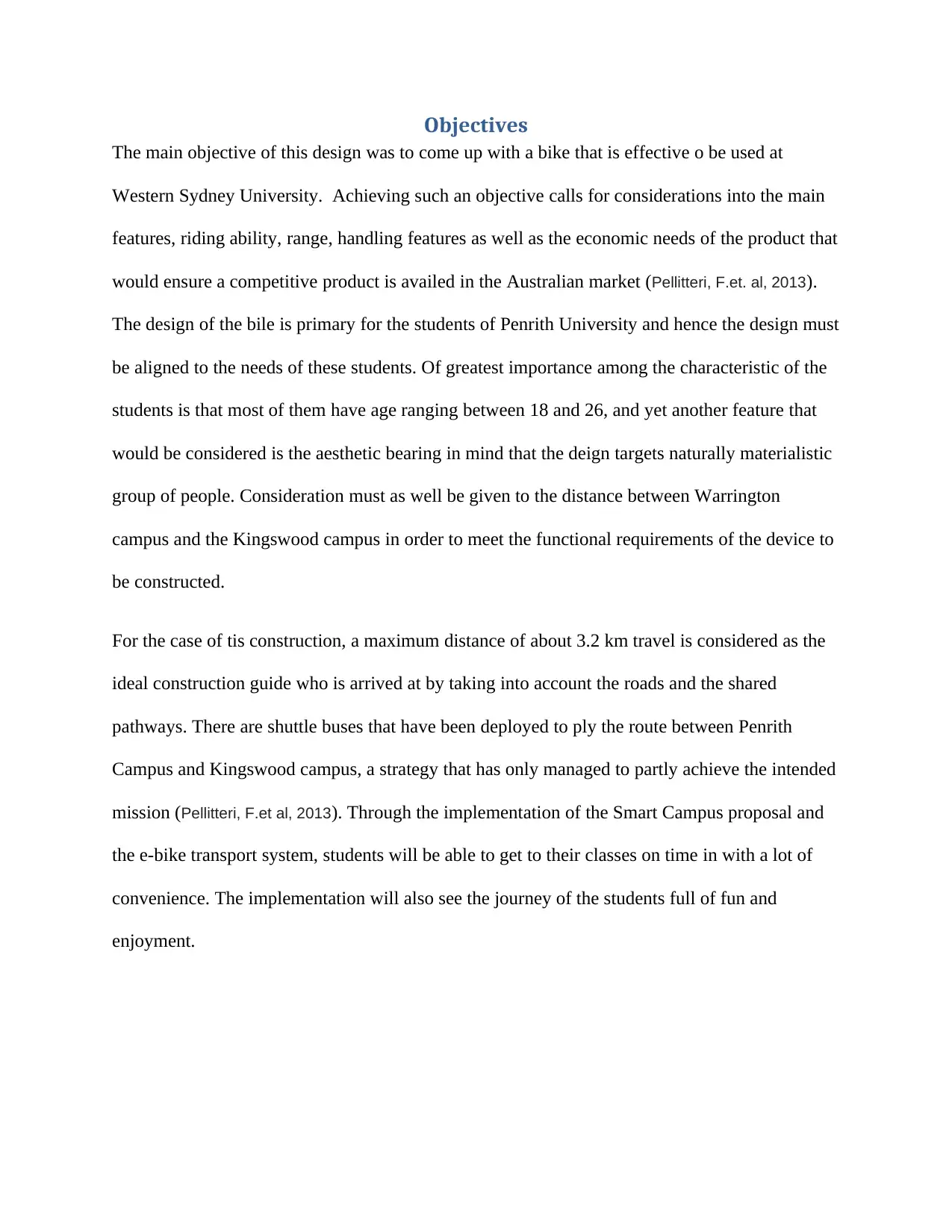
Objectives
The main objective of this design was to come up with a bike that is effective o be used at
Western Sydney University. Achieving such an objective calls for considerations into the main
features, riding ability, range, handling features as well as the economic needs of the product that
would ensure a competitive product is availed in the Australian market (Pellitteri, F.et. al, 2013).
The design of the bile is primary for the students of Penrith University and hence the design must
be aligned to the needs of these students. Of greatest importance among the characteristic of the
students is that most of them have age ranging between 18 and 26, and yet another feature that
would be considered is the aesthetic bearing in mind that the deign targets naturally materialistic
group of people. Consideration must as well be given to the distance between Warrington
campus and the Kingswood campus in order to meet the functional requirements of the device to
be constructed.
For the case of tis construction, a maximum distance of about 3.2 km travel is considered as the
ideal construction guide who is arrived at by taking into account the roads and the shared
pathways. There are shuttle buses that have been deployed to ply the route between Penrith
Campus and Kingswood campus, a strategy that has only managed to partly achieve the intended
mission (Pellitteri, F.et al, 2013). Through the implementation of the Smart Campus proposal and
the e-bike transport system, students will be able to get to their classes on time in with a lot of
convenience. The implementation will also see the journey of the students full of fun and
enjoyment.
The main objective of this design was to come up with a bike that is effective o be used at
Western Sydney University. Achieving such an objective calls for considerations into the main
features, riding ability, range, handling features as well as the economic needs of the product that
would ensure a competitive product is availed in the Australian market (Pellitteri, F.et. al, 2013).
The design of the bile is primary for the students of Penrith University and hence the design must
be aligned to the needs of these students. Of greatest importance among the characteristic of the
students is that most of them have age ranging between 18 and 26, and yet another feature that
would be considered is the aesthetic bearing in mind that the deign targets naturally materialistic
group of people. Consideration must as well be given to the distance between Warrington
campus and the Kingswood campus in order to meet the functional requirements of the device to
be constructed.
For the case of tis construction, a maximum distance of about 3.2 km travel is considered as the
ideal construction guide who is arrived at by taking into account the roads and the shared
pathways. There are shuttle buses that have been deployed to ply the route between Penrith
Campus and Kingswood campus, a strategy that has only managed to partly achieve the intended
mission (Pellitteri, F.et al, 2013). Through the implementation of the Smart Campus proposal and
the e-bike transport system, students will be able to get to their classes on time in with a lot of
convenience. The implementation will also see the journey of the students full of fun and
enjoyment.
⊘ This is a preview!⊘
Do you want full access?
Subscribe today to unlock all pages.

Trusted by 1+ million students worldwide
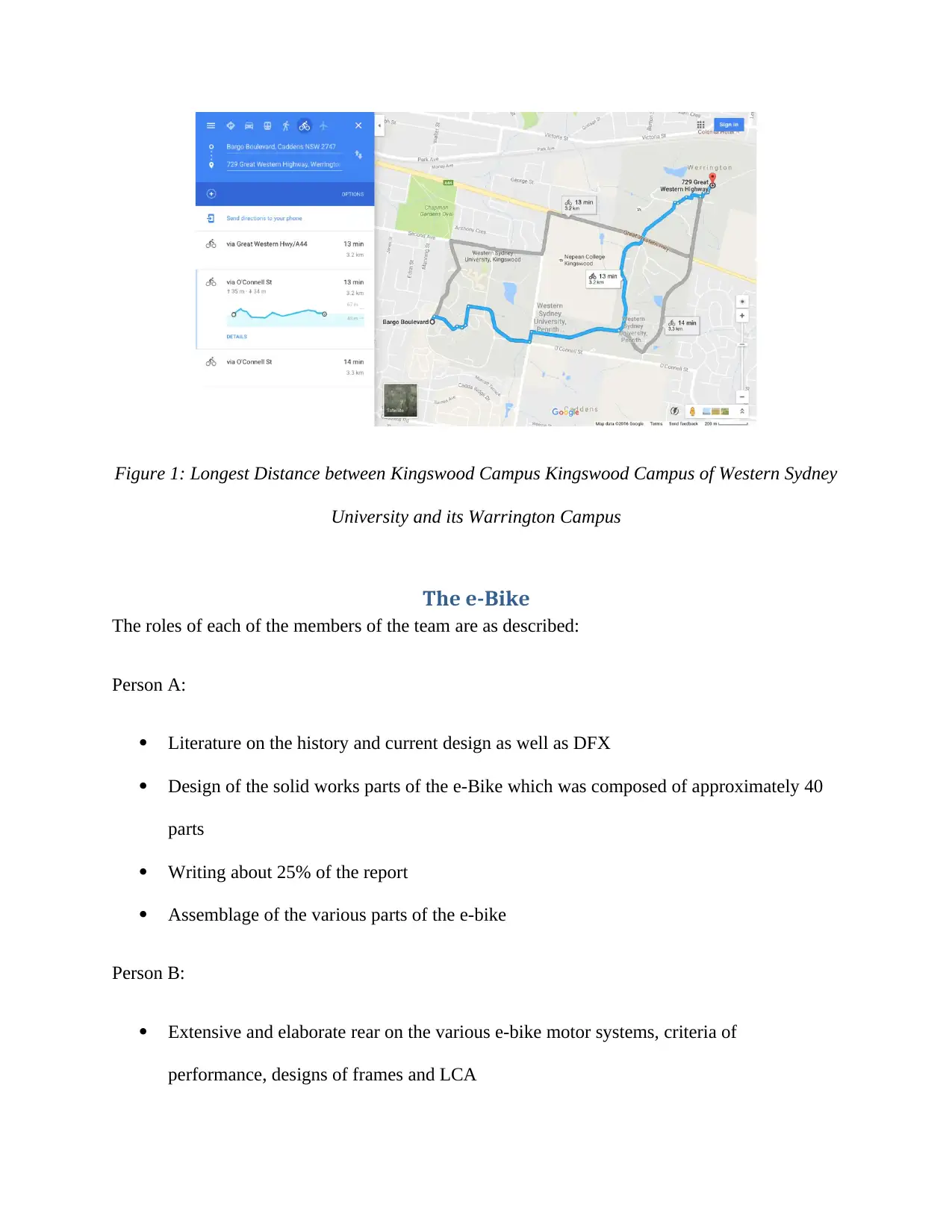
Figure 1: Longest Distance between Kingswood Campus Kingswood Campus of Western Sydney
University and its Warrington Campus
The e-Bike
The roles of each of the members of the team are as described:
Person A:
Literature on the history and current design as well as DFX
Design of the solid works parts of the e-Bike which was composed of approximately 40
parts
Writing about 25% of the report
Assemblage of the various parts of the e-bike
Person B:
Extensive and elaborate rear on the various e-bike motor systems, criteria of
performance, designs of frames and LCA
University and its Warrington Campus
The e-Bike
The roles of each of the members of the team are as described:
Person A:
Literature on the history and current design as well as DFX
Design of the solid works parts of the e-Bike which was composed of approximately 40
parts
Writing about 25% of the report
Assemblage of the various parts of the e-bike
Person B:
Extensive and elaborate rear on the various e-bike motor systems, criteria of
performance, designs of frames and LCA
Paraphrase This Document
Need a fresh take? Get an instant paraphrase of this document with our AI Paraphraser
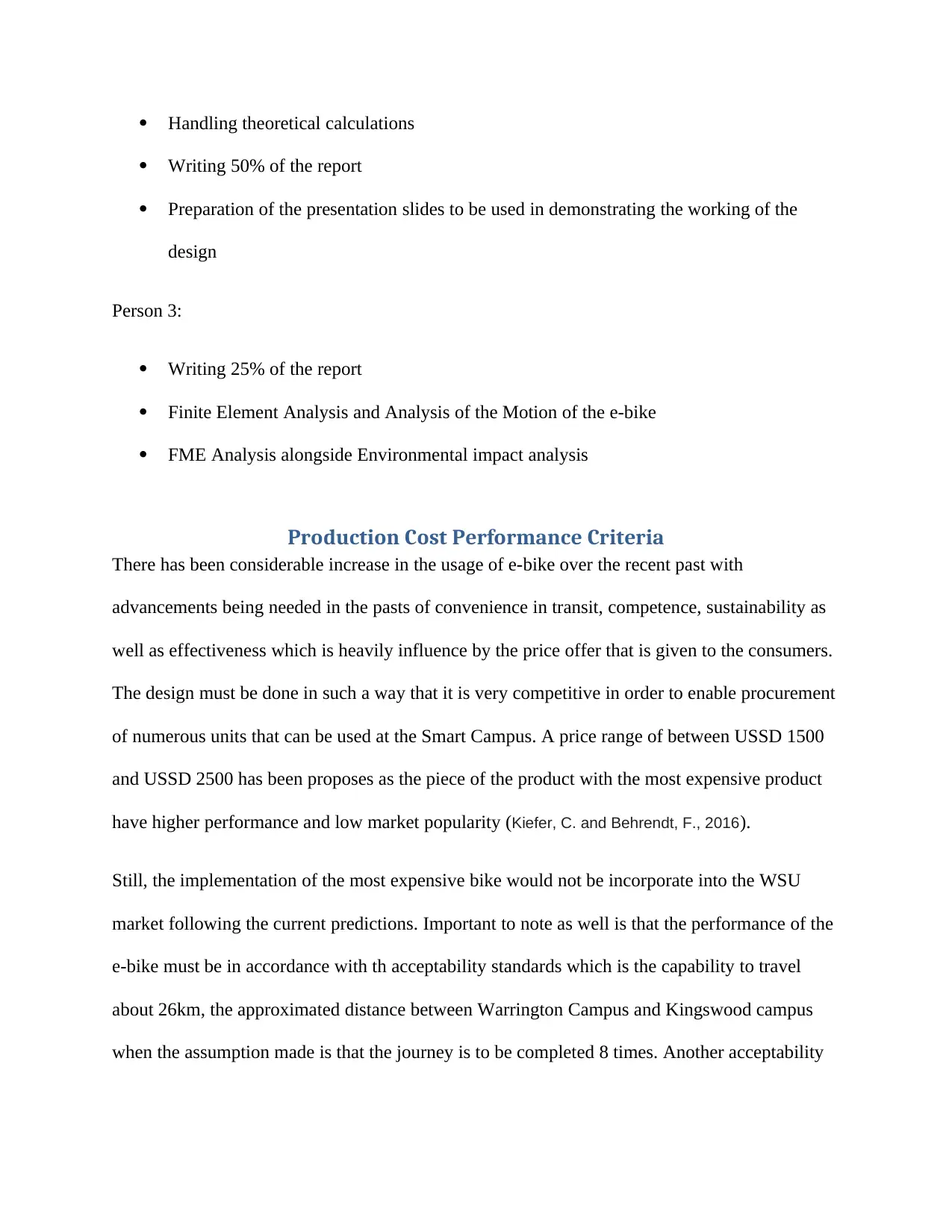
Handling theoretical calculations
Writing 50% of the report
Preparation of the presentation slides to be used in demonstrating the working of the
design
Person 3:
Writing 25% of the report
Finite Element Analysis and Analysis of the Motion of the e-bike
FME Analysis alongside Environmental impact analysis
Production Cost Performance Criteria
There has been considerable increase in the usage of e-bike over the recent past with
advancements being needed in the pasts of convenience in transit, competence, sustainability as
well as effectiveness which is heavily influence by the price offer that is given to the consumers.
The design must be done in such a way that it is very competitive in order to enable procurement
of numerous units that can be used at the Smart Campus. A price range of between USSD 1500
and USSD 2500 has been proposes as the piece of the product with the most expensive product
have higher performance and low market popularity (Kiefer, C. and Behrendt, F., 2016).
Still, the implementation of the most expensive bike would not be incorporate into the WSU
market following the current predictions. Important to note as well is that the performance of the
e-bike must be in accordance with th acceptability standards which is the capability to travel
about 26km, the approximated distance between Warrington Campus and Kingswood campus
when the assumption made is that the journey is to be completed 8 times. Another acceptability
Writing 50% of the report
Preparation of the presentation slides to be used in demonstrating the working of the
design
Person 3:
Writing 25% of the report
Finite Element Analysis and Analysis of the Motion of the e-bike
FME Analysis alongside Environmental impact analysis
Production Cost Performance Criteria
There has been considerable increase in the usage of e-bike over the recent past with
advancements being needed in the pasts of convenience in transit, competence, sustainability as
well as effectiveness which is heavily influence by the price offer that is given to the consumers.
The design must be done in such a way that it is very competitive in order to enable procurement
of numerous units that can be used at the Smart Campus. A price range of between USSD 1500
and USSD 2500 has been proposes as the piece of the product with the most expensive product
have higher performance and low market popularity (Kiefer, C. and Behrendt, F., 2016).
Still, the implementation of the most expensive bike would not be incorporate into the WSU
market following the current predictions. Important to note as well is that the performance of the
e-bike must be in accordance with th acceptability standards which is the capability to travel
about 26km, the approximated distance between Warrington Campus and Kingswood campus
when the assumption made is that the journey is to be completed 8 times. Another acceptability
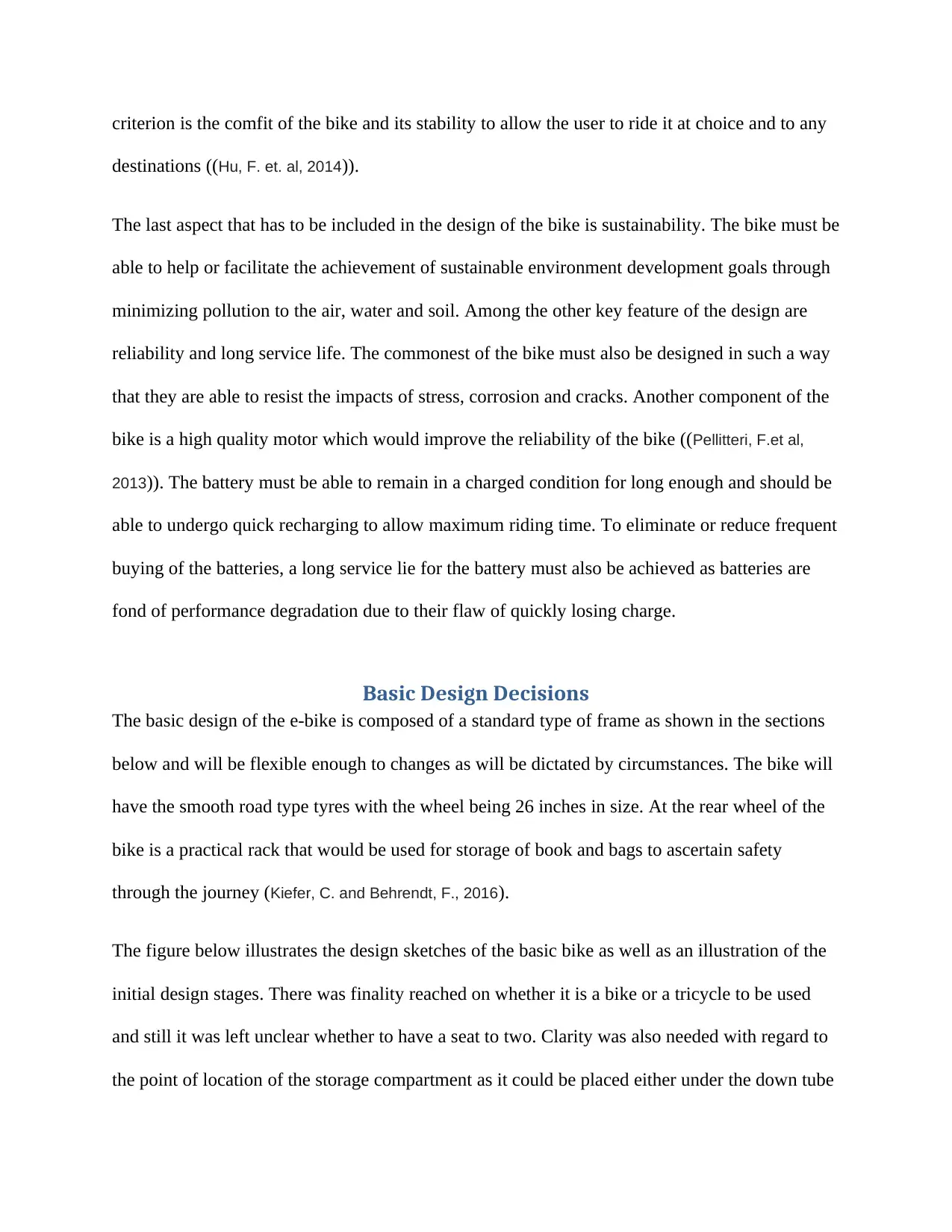
criterion is the comfit of the bike and its stability to allow the user to ride it at choice and to any
destinations ((Hu, F. et. al, 2014)).
The last aspect that has to be included in the design of the bike is sustainability. The bike must be
able to help or facilitate the achievement of sustainable environment development goals through
minimizing pollution to the air, water and soil. Among the other key feature of the design are
reliability and long service life. The commonest of the bike must also be designed in such a way
that they are able to resist the impacts of stress, corrosion and cracks. Another component of the
bike is a high quality motor which would improve the reliability of the bike ((Pellitteri, F.et al,
2013)). The battery must be able to remain in a charged condition for long enough and should be
able to undergo quick recharging to allow maximum riding time. To eliminate or reduce frequent
buying of the batteries, a long service lie for the battery must also be achieved as batteries are
fond of performance degradation due to their flaw of quickly losing charge.
Basic Design Decisions
The basic design of the e-bike is composed of a standard type of frame as shown in the sections
below and will be flexible enough to changes as will be dictated by circumstances. The bike will
have the smooth road type tyres with the wheel being 26 inches in size. At the rear wheel of the
bike is a practical rack that would be used for storage of book and bags to ascertain safety
through the journey (Kiefer, C. and Behrendt, F., 2016).
The figure below illustrates the design sketches of the basic bike as well as an illustration of the
initial design stages. There was finality reached on whether it is a bike or a tricycle to be used
and still it was left unclear whether to have a seat to two. Clarity was also needed with regard to
the point of location of the storage compartment as it could be placed either under the down tube
destinations ((Hu, F. et. al, 2014)).
The last aspect that has to be included in the design of the bike is sustainability. The bike must be
able to help or facilitate the achievement of sustainable environment development goals through
minimizing pollution to the air, water and soil. Among the other key feature of the design are
reliability and long service life. The commonest of the bike must also be designed in such a way
that they are able to resist the impacts of stress, corrosion and cracks. Another component of the
bike is a high quality motor which would improve the reliability of the bike ((Pellitteri, F.et al,
2013)). The battery must be able to remain in a charged condition for long enough and should be
able to undergo quick recharging to allow maximum riding time. To eliminate or reduce frequent
buying of the batteries, a long service lie for the battery must also be achieved as batteries are
fond of performance degradation due to their flaw of quickly losing charge.
Basic Design Decisions
The basic design of the e-bike is composed of a standard type of frame as shown in the sections
below and will be flexible enough to changes as will be dictated by circumstances. The bike will
have the smooth road type tyres with the wheel being 26 inches in size. At the rear wheel of the
bike is a practical rack that would be used for storage of book and bags to ascertain safety
through the journey (Kiefer, C. and Behrendt, F., 2016).
The figure below illustrates the design sketches of the basic bike as well as an illustration of the
initial design stages. There was finality reached on whether it is a bike or a tricycle to be used
and still it was left unclear whether to have a seat to two. Clarity was also needed with regard to
the point of location of the storage compartment as it could be placed either under the down tube
⊘ This is a preview!⊘
Do you want full access?
Subscribe today to unlock all pages.

Trusted by 1+ million students worldwide
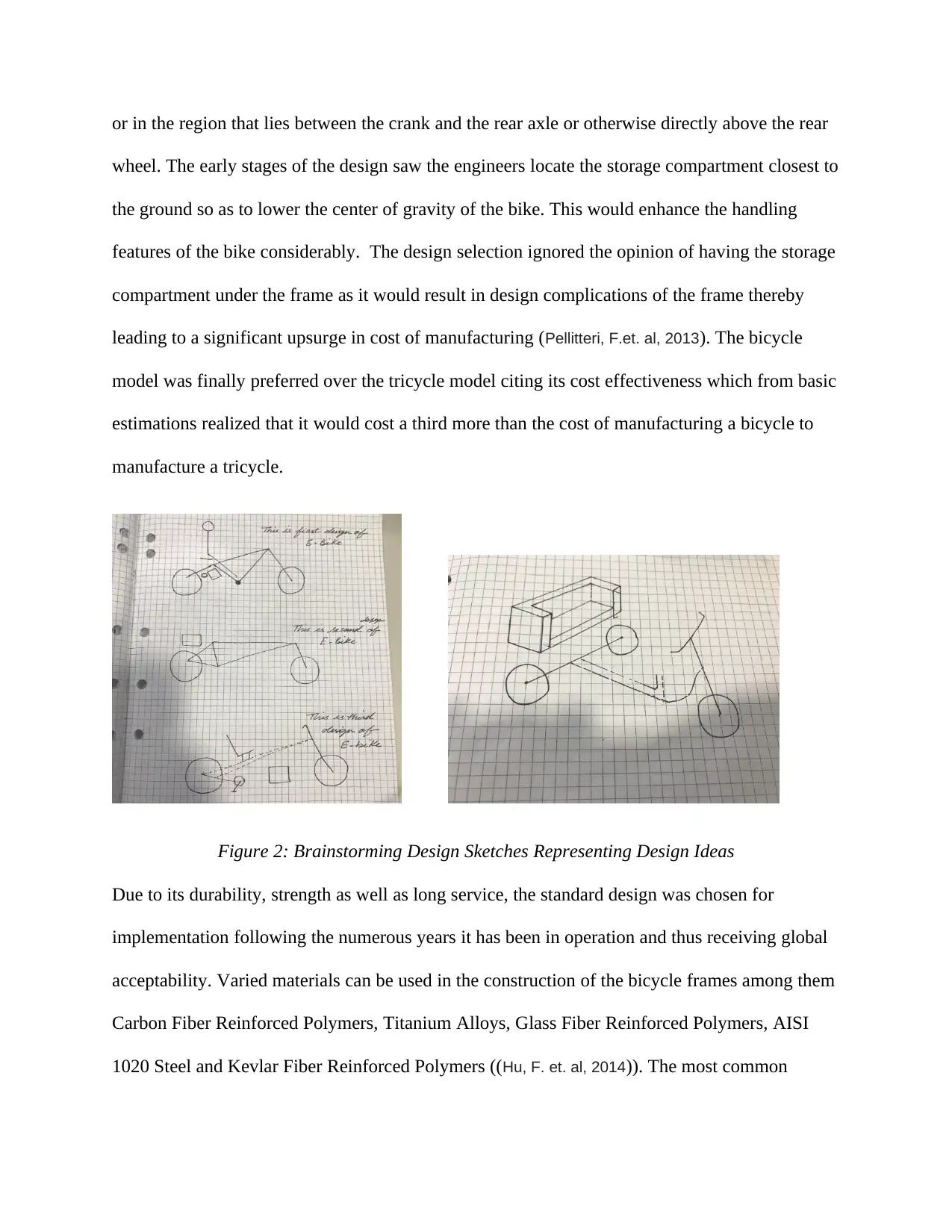
or in the region that lies between the crank and the rear axle or otherwise directly above the rear
wheel. The early stages of the design saw the engineers locate the storage compartment closest to
the ground so as to lower the center of gravity of the bike. This would enhance the handling
features of the bike considerably. The design selection ignored the opinion of having the storage
compartment under the frame as it would result in design complications of the frame thereby
leading to a significant upsurge in cost of manufacturing (Pellitteri, F.et. al, 2013). The bicycle
model was finally preferred over the tricycle model citing its cost effectiveness which from basic
estimations realized that it would cost a third more than the cost of manufacturing a bicycle to
manufacture a tricycle.
Figure 2: Brainstorming Design Sketches Representing Design Ideas
Due to its durability, strength as well as long service, the standard design was chosen for
implementation following the numerous years it has been in operation and thus receiving global
acceptability. Varied materials can be used in the construction of the bicycle frames among them
Carbon Fiber Reinforced Polymers, Titanium Alloys, Glass Fiber Reinforced Polymers, AISI
1020 Steel and Kevlar Fiber Reinforced Polymers ((Hu, F. et. al, 2014)). The most common
wheel. The early stages of the design saw the engineers locate the storage compartment closest to
the ground so as to lower the center of gravity of the bike. This would enhance the handling
features of the bike considerably. The design selection ignored the opinion of having the storage
compartment under the frame as it would result in design complications of the frame thereby
leading to a significant upsurge in cost of manufacturing (Pellitteri, F.et. al, 2013). The bicycle
model was finally preferred over the tricycle model citing its cost effectiveness which from basic
estimations realized that it would cost a third more than the cost of manufacturing a bicycle to
manufacture a tricycle.
Figure 2: Brainstorming Design Sketches Representing Design Ideas
Due to its durability, strength as well as long service, the standard design was chosen for
implementation following the numerous years it has been in operation and thus receiving global
acceptability. Varied materials can be used in the construction of the bicycle frames among them
Carbon Fiber Reinforced Polymers, Titanium Alloys, Glass Fiber Reinforced Polymers, AISI
1020 Steel and Kevlar Fiber Reinforced Polymers ((Hu, F. et. al, 2014)). The most common
Paraphrase This Document
Need a fresh take? Get an instant paraphrase of this document with our AI Paraphraser
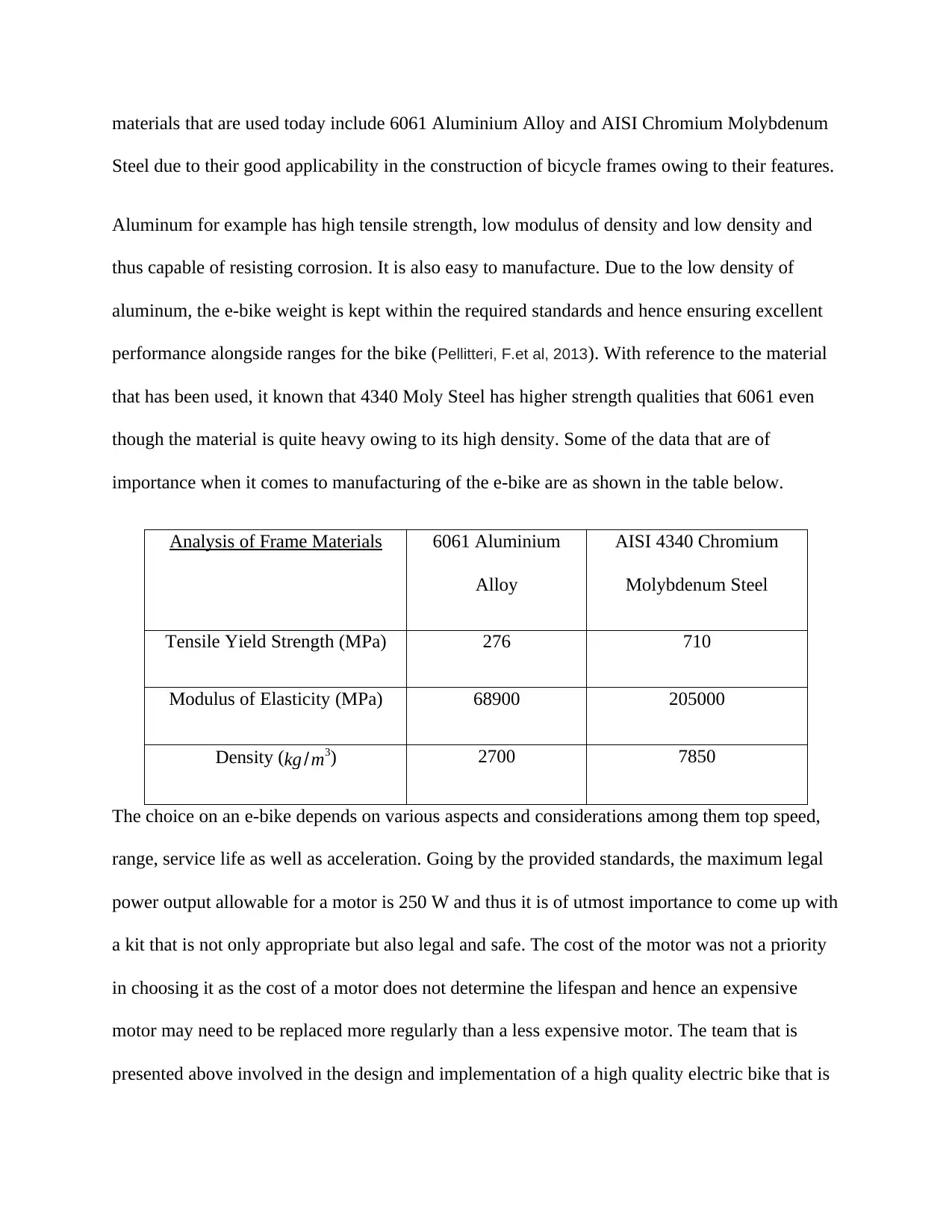
materials that are used today include 6061 Aluminium Alloy and AISI Chromium Molybdenum
Steel due to their good applicability in the construction of bicycle frames owing to their features.
Aluminum for example has high tensile strength, low modulus of density and low density and
thus capable of resisting corrosion. It is also easy to manufacture. Due to the low density of
aluminum, the e-bike weight is kept within the required standards and hence ensuring excellent
performance alongside ranges for the bike (Pellitteri, F.et al, 2013). With reference to the material
that has been used, it known that 4340 Moly Steel has higher strength qualities that 6061 even
though the material is quite heavy owing to its high density. Some of the data that are of
importance when it comes to manufacturing of the e-bike are as shown in the table below.
Analysis of Frame Materials 6061 Aluminium
Alloy
AISI 4340 Chromium
Molybdenum Steel
Tensile Yield Strength (MPa) 276 710
Modulus of Elasticity (MPa) 68900 205000
Density (kg / m3) 2700 7850
The choice on an e-bike depends on various aspects and considerations among them top speed,
range, service life as well as acceleration. Going by the provided standards, the maximum legal
power output allowable for a motor is 250 W and thus it is of utmost importance to come up with
a kit that is not only appropriate but also legal and safe. The cost of the motor was not a priority
in choosing it as the cost of a motor does not determine the lifespan and hence an expensive
motor may need to be replaced more regularly than a less expensive motor. The team that is
presented above involved in the design and implementation of a high quality electric bike that is
Steel due to their good applicability in the construction of bicycle frames owing to their features.
Aluminum for example has high tensile strength, low modulus of density and low density and
thus capable of resisting corrosion. It is also easy to manufacture. Due to the low density of
aluminum, the e-bike weight is kept within the required standards and hence ensuring excellent
performance alongside ranges for the bike (Pellitteri, F.et al, 2013). With reference to the material
that has been used, it known that 4340 Moly Steel has higher strength qualities that 6061 even
though the material is quite heavy owing to its high density. Some of the data that are of
importance when it comes to manufacturing of the e-bike are as shown in the table below.
Analysis of Frame Materials 6061 Aluminium
Alloy
AISI 4340 Chromium
Molybdenum Steel
Tensile Yield Strength (MPa) 276 710
Modulus of Elasticity (MPa) 68900 205000
Density (kg / m3) 2700 7850
The choice on an e-bike depends on various aspects and considerations among them top speed,
range, service life as well as acceleration. Going by the provided standards, the maximum legal
power output allowable for a motor is 250 W and thus it is of utmost importance to come up with
a kit that is not only appropriate but also legal and safe. The cost of the motor was not a priority
in choosing it as the cost of a motor does not determine the lifespan and hence an expensive
motor may need to be replaced more regularly than a less expensive motor. The team that is
presented above involved in the design and implementation of a high quality electric bike that is
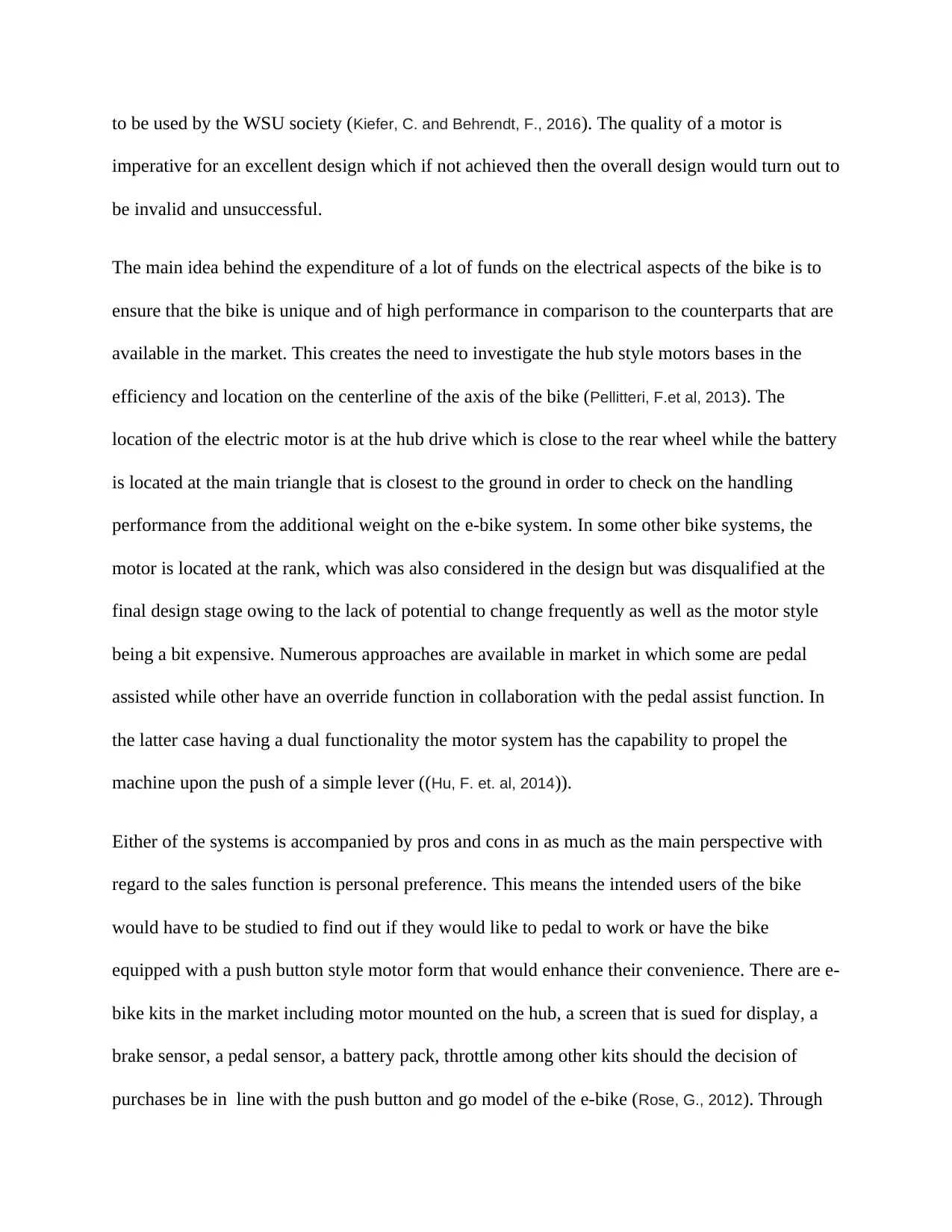
to be used by the WSU society (Kiefer, C. and Behrendt, F., 2016). The quality of a motor is
imperative for an excellent design which if not achieved then the overall design would turn out to
be invalid and unsuccessful.
The main idea behind the expenditure of a lot of funds on the electrical aspects of the bike is to
ensure that the bike is unique and of high performance in comparison to the counterparts that are
available in the market. This creates the need to investigate the hub style motors bases in the
efficiency and location on the centerline of the axis of the bike (Pellitteri, F.et al, 2013). The
location of the electric motor is at the hub drive which is close to the rear wheel while the battery
is located at the main triangle that is closest to the ground in order to check on the handling
performance from the additional weight on the e-bike system. In some other bike systems, the
motor is located at the rank, which was also considered in the design but was disqualified at the
final design stage owing to the lack of potential to change frequently as well as the motor style
being a bit expensive. Numerous approaches are available in market in which some are pedal
assisted while other have an override function in collaboration with the pedal assist function. In
the latter case having a dual functionality the motor system has the capability to propel the
machine upon the push of a simple lever ((Hu, F. et. al, 2014)).
Either of the systems is accompanied by pros and cons in as much as the main perspective with
regard to the sales function is personal preference. This means the intended users of the bike
would have to be studied to find out if they would like to pedal to work or have the bike
equipped with a push button style motor form that would enhance their convenience. There are e-
bike kits in the market including motor mounted on the hub, a screen that is sued for display, a
brake sensor, a pedal sensor, a battery pack, throttle among other kits should the decision of
purchases be in line with the push button and go model of the e-bike (Rose, G., 2012). Through
imperative for an excellent design which if not achieved then the overall design would turn out to
be invalid and unsuccessful.
The main idea behind the expenditure of a lot of funds on the electrical aspects of the bike is to
ensure that the bike is unique and of high performance in comparison to the counterparts that are
available in the market. This creates the need to investigate the hub style motors bases in the
efficiency and location on the centerline of the axis of the bike (Pellitteri, F.et al, 2013). The
location of the electric motor is at the hub drive which is close to the rear wheel while the battery
is located at the main triangle that is closest to the ground in order to check on the handling
performance from the additional weight on the e-bike system. In some other bike systems, the
motor is located at the rank, which was also considered in the design but was disqualified at the
final design stage owing to the lack of potential to change frequently as well as the motor style
being a bit expensive. Numerous approaches are available in market in which some are pedal
assisted while other have an override function in collaboration with the pedal assist function. In
the latter case having a dual functionality the motor system has the capability to propel the
machine upon the push of a simple lever ((Hu, F. et. al, 2014)).
Either of the systems is accompanied by pros and cons in as much as the main perspective with
regard to the sales function is personal preference. This means the intended users of the bike
would have to be studied to find out if they would like to pedal to work or have the bike
equipped with a push button style motor form that would enhance their convenience. There are e-
bike kits in the market including motor mounted on the hub, a screen that is sued for display, a
brake sensor, a pedal sensor, a battery pack, throttle among other kits should the decision of
purchases be in line with the push button and go model of the e-bike (Rose, G., 2012). Through
⊘ This is a preview!⊘
Do you want full access?
Subscribe today to unlock all pages.

Trusted by 1+ million students worldwide
1 out of 36
Your All-in-One AI-Powered Toolkit for Academic Success.
+13062052269
info@desklib.com
Available 24*7 on WhatsApp / Email
![[object Object]](/_next/static/media/star-bottom.7253800d.svg)
Unlock your academic potential
Copyright © 2020–2025 A2Z Services. All Rights Reserved. Developed and managed by ZUCOL.